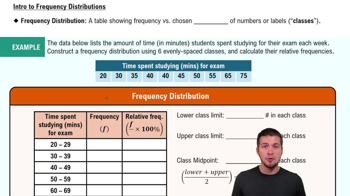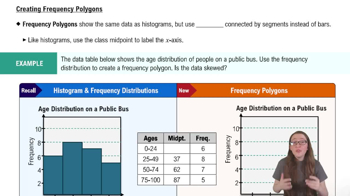Here are the essential concepts you must grasp in order to answer the question correctly.
F Distribution
The F distribution is a probability distribution that arises frequently in statistics, particularly in the context of variance analysis. It is defined by two parameters, the degrees of freedom for the numerator and the denominator, which correspond to the variances being compared. The F distribution is used to determine if there are significant differences between the variances of two or more groups.
Recommended video:
Intro to Frequency Distributions
Skewness
Skewness refers to the asymmetry of a probability distribution. A distribution is said to be skewed left (negatively skewed) if it has a longer tail on the left side, while it is skewed right (positively skewed) if the tail is longer on the right side. Understanding skewness is crucial for interpreting the shape of the distribution and its implications for statistical analysis.
Recommended video:
Creating Frequency Polygons
Properties of the F Distribution
The F distribution is inherently right-skewed, meaning it has a longer tail on the right side. This characteristic is important when conducting hypothesis tests, as it affects the critical values used to determine statistical significance. The right skewness indicates that most of the values are concentrated on the left, with fewer extreme values on the right, which is typical in variance comparisons.
Recommended video:
Intro to Frequency Distributions





